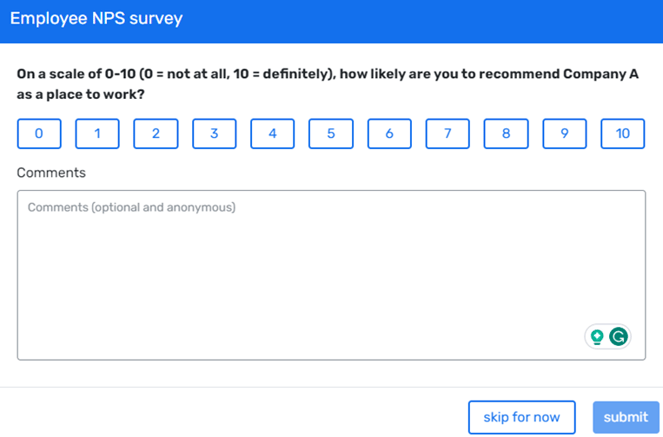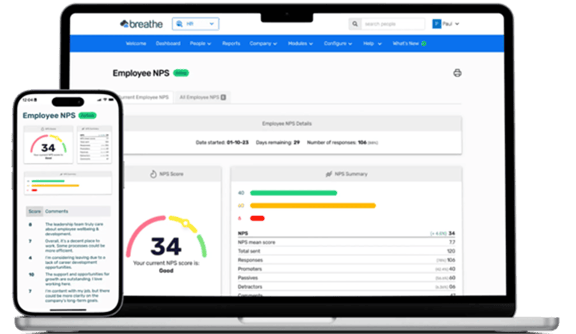With staff turnover costing around 33% of each employee’s base pay in 2023, boosting engagement & retention has never been more important for SMEs.
And salary alone is no longer enough – employees want to know their organisation is listening to them.
But how can small businesses truly monitor engagement, or get measurable data around how people feel about where they work?
That’s where Employee Net Promoter Score comes in. With HR software that offers an Employee NPS feature, you’ll easily be able to take a temperature check of how your employees are feeling about the business.
In this blog, we asked Steven Rabson Stark, founder of 360-degree feedback platform AdviceSheet & Breathe partner, for advice on how SMEs can ensure their team feels genuinely listened to - and improve low NPS scores.
Skip to:
What is Employee Net Promoter Score (eNPS)?
What do the Employee Net Promoter Score categories mean?
8 ways Breathe's Employee Net Promoter Score feature can help your SME
5 ways to improve your NPS score
How Employee Net Promoter Score can elevate HR analytics
What is Employee Net Promoter Score (eNPS)?
Also known as Employee NPS, or eNPS, Employee Net Promoter Score is a metric that employers can use to monitor employee engagement. Recipients of the survey are asked to rate a question on a scale of 1-10. Usually this is around how likely the respondent is to recommend a company (either from a customer or employee perspective).
The overall Employee NPS score is made up of subtracting the percentage of detractors from the percentage of promoters (we’ll get to these descriptions shortly).
In Breathe’s Employee Net Promoter Score feature, employees are asked the question “On a scale of 1-10 (0 = not at all, 10 = definitely), how likely are you to recommend [company name] as a place to work?” There’s also a field to allow for anonymous, optional comments to help you make any necessary changes.

Please note, Breathe’s Employee Net Promoter Score feature is available on Regular plans & above.
What do the Employee Net Promoter Score categories mean?
Here, we’ll detail what the individual Employee NPS categories mean, along with what this means for your SME.
Promoters
Promoters are those that provide a score of 9 or 10 – these are championing the cause and could easily be seen as happy employees that advocate for the business.
Passives
Those that score 7 or 8 in Employee NPS are known as passives. Whilst this score might still seem high, in terms of ranking these employees are known as neutrals. Their scores also don’t form part of the overall scoring formula. But it’s good for employers to know that with the right changes, these employees could easily evolve into promoters.
Detractors
Detractors are those that provide a score of between 0-6 on the Employee NPS scale. These employees are generally considered to be unsatisfied. With detractors, it’s important for businesses to understand where this score has come from – and to encourage feedback so that changes can be made.
Whilst the data in Breathe’s Employee Net Promoter Score feature is anonymised (to allow for the most honest feedback possible), receiving results that include detractors is still an indication of work that might be needed to improve employee communications, or supporting initiatives.

8 ways Breathe’s Employee Net Promoter Score (NPS) feature can help your SME
Breathe’s Employee Net Promoter Score (NPS) feature can support your HR data & allow you to gain key insights from your team. Here’s how:
-
The feature offers an employee ‘pulse check’ – allowing HR to understand more about how your team are feeling about work.
-
You’ll receive anonymous, honest feedback in data form, supporting HR analytics.
-
Allowing employees to feel listened to boosts productivity and supports retention. Over a third of UK employees leave their organisations each year, on average, so minimising turnover rates is crucial.
-
Easily run periodic surveys (as often as you want to).
-
Scores could start the conversations needed to enforce change & prevent turnover.
-
The form is one simple question, meaning it’s quick & easy for your team to complete (increasing the likelihood of higher response rates).
-
Built-in reporting shows a breakdown of promoters, passives & detractors.
-
And lastly, there’s no need to purchase additional software – Breathe’s got you covered with everything under one roof.
5 ways to improve your NPS score
If you’ve run an Employee NPS survey and the results aren’t quite as you’d hoped – or are even a bit of a shock – how can you move forward & eventually improve the score?
Of course, the way your employees are feeling isn’t going to change overnight. But with time & the right communication and changes, scores can improve.
In this section, we look at 5 practical ways SMEs can improve less-than-optimal NPS scores:
1. Listen – and understand where your team are coming from
Breathe partner & founder of AdviceSheet, Steven Rabson Stark, says that businesses need to create a psychologically safe space for their people to air their concerns – and really listen.
“If you’re surprised or concerned about a low NPS score, you need to find a way to understand what is really going on for people. This means having a safe conversation in which you really listen. It’s so common for organisations to run a ‘consultation’ or a ‘listening exercise’ that leaves people feeling neither consulted nor listened to. Indeed, experiences like those might in part be what lie behind a low score.”
2. Ensure complete anonymity
Reassure your team that their answers are - and will remain - anonymous. This helps to build trust with your employees and supports creating the truly safe space Steven mentioned earlier.
3. Recognise your people
Saying a genuine thank you or well done doesn’t need to be expensive. If you don’t already offer recognition tools like kudos, Breathe’s appreciation tool, a simple, sincere ‘thank you’ for someone’s hard work or efforts often goes a long way.
And it doesn’t necessarily have to be strictly work-related, either. Letting someone know they handled a difficult conversation well, or noticing how they went out of their way to support a colleague is always appreciated (and takes just a few seconds).
4. Focus leadership attention
NPS data can help to get buy-in from the decision-makers of your organisation to implement the necessary changes within your SME – whether this is making cultural changes to ensure the safe spaces for people to air concerns, or with other engagement initiatives.
Steven Rabson Stark shares how NPS data can provide a focal point for change & maintaining a healthy company culture.
"Leaders juggle many priorities and getting their attention can be hard. The NPS data doesn’t just show how you are doing, it also provides a fast & succinct point of focus for leaders. If the score is good and stable, leaders can focus elsewhere. If it is trending down or takes a sudden dive, it will focus their attention rapidly. That’s useful. NPS gives you a language and a measure to start managing culture in a more intentional way. And if you aren't the leader in an organisation, it gives you tools to keep leaders focused on enabling a positive culture."
5. Use tools & data to support communication
So, you know what you need to do to listen to your employees and to make some changes – but where to begin? Steven Rabson Stark has small businesses covered.
“To improve NPS scores for people & businesses alike, you need to find a way to hear from people that is psychologically safe for them to take part in, and you need to be prepared to mitigate their concerns.
We use a tool called once and future stories that helps people share safely and can give you lots of qualitative data. It also moves the conversation on to what might be done about issues and it opens the door to doing that collectively, which is the best, most empowering outcome possible.”
But ultimately, don’t be disheartened if you do receive a lower-than-expected Employee NPS Score. Steven Rabson Stark shares his uplifting advice for businesses in this situation:
"The key thing to remember is that getting a low score might be the best thing to happen, because it's the start of things getting better."
Steven Rabson Stark, founder of AdviceSheet.
How Employee Net Promoter Score can elevate HR analytics
Using tools such as Employee Net Promoter Score can help HR to gather data & gain insights through analytics.
Performing the survey in Breathe & monitoring the results can help HR teams to monitor engagement & provide an insight into motivation levels within your SME.
Employee NPS scores can help provide indicators around employee retention levels or flag when turnover might be likely.
This can prompt initiatives to help re-engage teams or address concerns in a different way with employees – either way, it starts the conversation & gets those lines of communication going.
Using Employee Net Promoter Scores to listen to your people
Listening to your team is powerful – with long-lasting effects on engagement & retention.
Why not survey your people today and see what the results are for your SME?
The Employee Net Promoter Score feature is available for free on Regular Breathe plans & above. Start your free 14-day trial today.
Steven Rabson Stark is the founder of AdviceSheet & a partner of Breathe.

Author: Aimée Brougham-Chandler
An IDM-certified Digital Copywriter (2023) & English Language & Literature graduate (BA Hons), Aimée is Breathe's Content Assistant. With 3 years' content marketing experience, Aimée has a passion for writing - and providing SME HR teams with solutions to their problems. She enjoys delving into & demystifying all things HR: from employee performance to health and wellbeing, leave to company culture & much more.





